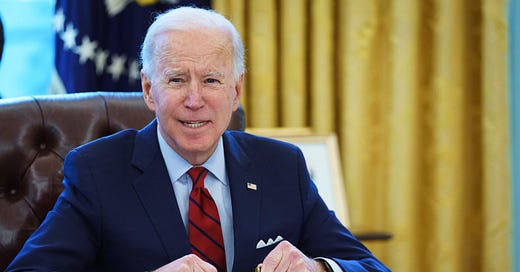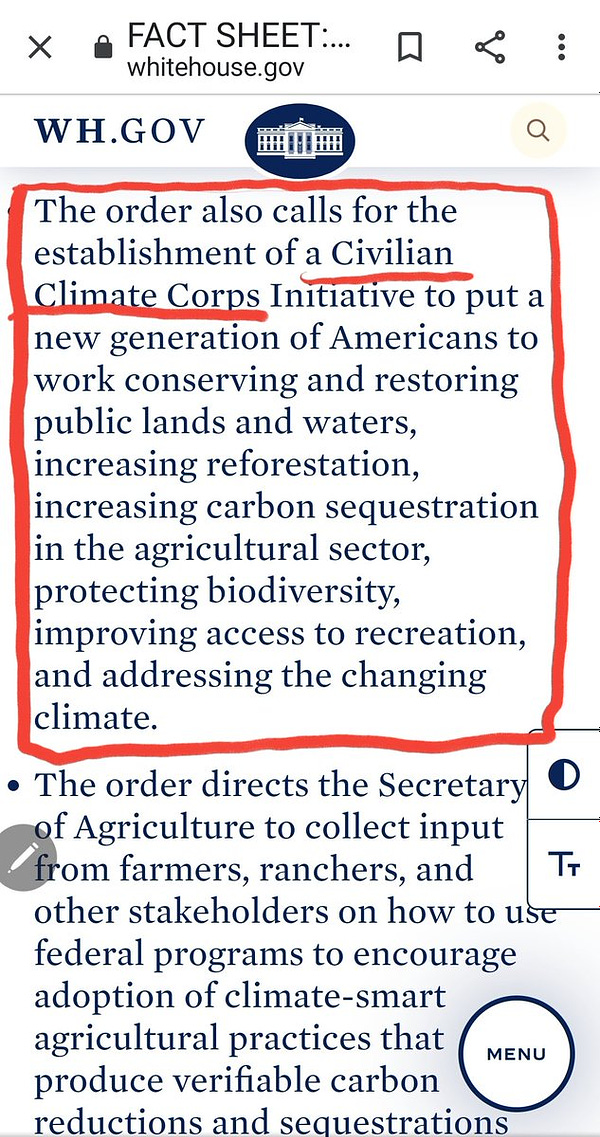Salutations, nuts and volts!
I’m still buried in energy transmission — there is more to come on that subject. (We’re having a Transmission Fortnight, turns out.) But I thought I should at least take note of the fact that President Joe Biden seems to be following my advice: he’s running a blitz.
I’m not going to get too deep into analyzing all of this, but I at least want to record what climate measures Biden has announced so far. Underneath, I’ll link to some good things to read about it.
Executive order-palooza
On his first day in office, Biden issued these executive orders:
The US will rejoin the Paris climate agreement.
Federal agencies will review all new and proposed Trump regulatory changes passed in the waning days of his presidency, and specifically revisit fuel economy standards.
The Keystone XL pipeline permit will be revoked.
Oil and gas leasing in the Arctic National Wildlife Refuge will be paused.
The Office of Budget and Management (OMB) will oversee what could be an extremely consequential bid to “modernize and improve” the regulatory review process in order to, in the White House’s language, “promote public health and safety, economic growth, social welfare, racial justice, environmental stewardship, human dignity, equity, and the interests of future generations.”
Then, on Wednesday (“Climate Day”!), he issued a slew of others:
Foreign policy
Climate change will be at the heart of US foreign policy and diplomacy.
There will be a Special Presidential Envoy for Climate who will have a seat on the National Security Council and press for climate ambition across international engagements.
In addition to rejoining Paris, the US will set out to substantially increase the ambition of the framework and will begin crafting a new US “nationally defined contribution” (NDC) to the process.
The US will host a Leaders’ Climate Summit on Earth Day, April 22, 2021, to underscore the administration’s new commitment.
The US will work to end international fossil fuel financing (through Import-Export Bank and other international financial institutions) and create a plan for financing clean-energy development in emerging economies.
Among other foreign-policy-related orders: the “Director of National Intelligence to prepare a National Intelligence Estimate on the security implications of climate change, the State Department to prepare a transmittal package to the Senate for the Kigali Amendment to the Montreal Protocol, and all agencies to develop strategies for integrating climate considerations into their international work.”
Whole-of-government approach
Creates a “White House Office of Domestic Climate Policy – led by the first-ever National Climate Advisor and Deputy National Climate Advisor” to coordinate the climate agenda from the Oval Office.
Creates a “National Climate Task Force, assembling leaders from across 21 federal agencies” to coordinate on climate policy.
Leverage government buying power and fossil-fuel footprint
Agencies will follow Biden’s “Buy American” order, procuring domestic electricity and zero-emission vehicles (ZEVs), and “apply and strictly enforce the prevailing wage and benefit guidelines of the Davis Bacon and other acts and encourage Project Labor Agreements.”
Each federal agency will develop a plan to assess and upgrade the resilience of its facilities.
(Though there is no formal executive order on it yet, Biden said on Monday that as part of his Buy American program, he would seek to replace the federal government’s entire fleet with electric vehicles. That would be an extremely big deal.)
The Secretary of Interior will pause oil and gas leasing on public lands and offshore waters “to the extent possible,” launch a review of existing leases, and work to “double renewable energy production from offshore wind by 2030.”
All federal agencies will be ordered to “eliminate fossil fuel subsidies as consistent with applicable law and identify new opportunities to spur innovation, commercialization, and deployment of clean energy technologies and infrastructure.”
Infrastructure
Ensures that every federal infrastructure investment reduces climate pollution and that permitting and siting of clean-energy projects on public land is accelerated.
Conservation, agriculture, and reforestation
The US will conserve “at least 30 percent of our lands and oceans by 2030.”
Creates a Civilian Climate Corps Initiative “to put a new generation of Americans to work conserving and restoring public lands and waters, increasing reforestation, increasing carbon sequestration in the agricultural sector, protecting biodiversity, improving access to recreation, and addressing the changing climate.”
The Secretary of Agriculture will being a process of stakeholder consultation aimed at spreading “climate-smart agricultural practices that produce verifiable carbon reductions and sequestrations.”
Energy communities
Creates an “Interagency Working Group on Coal and Power Plant Communities and Economic Revitalization, to be co-chaired by the National Climate Advisor and the Director of the National Economic Council,” which will coordinate cross-agency work to help “coal, oil and natural gas, and power plant communities.”
The Working Group will advance projects that reduce local environmental harms from existing and abandoned fossil fuel infrastructure.
The Working Group will explore efforts to revitalize brownfields and other degraded land.
Environmental justice
All federal agencies will “develop programs, policies, and activities to address the disproportionate health, environmental, economic, and climate impacts on disadvantaged communities.”
Creates a “White House Environmental Justice Interagency Council and a White House Environmental Justice Advisory Council to prioritize environmental justice and ensure a whole-of-government approach to addressing current and historical environmental injustices.” Ensures that environmental justice enforcement is boosted at the Environmental Protection Agency, Department of Justice, and Department of Health and Human Services.
Creates a “government-wide Justice40 Initiative,” with the goal of directing 40 percent of the benefits of all relevant federal investments to disadvantaged communities, as tracked by a new “Environmental Justice Scorecard.”
Creates a “Climate and Environmental Justice Screening Tool,” akin to the one EPA now uses, to identify disadvantaged communities and help direct aid in a uniform way across agencies.
Scientific integrity
“Directs agencies to make evidence-based decisions guided by the best available science and data.”
“Charges the Director of the Office of Science and Technology Policy (OSTP) with the responsibility for ensuring scientific integrity across federal agencies.”
All agencies involved with research will appoint a senior career appointee as Chief Science Officer to ensure scientific integrity.
Reestablishes the President’s Council of Advisors on Science and Technology, aka PCAST (which Trump disbanded), co-chaired by the President’s Science Advisor, to “advise the President on policy that affects science, technology, and innovation” and otherwise provide policy-relevant scientific and technical information.
Holy sh*t that’s a lot of stuff!
There is obviously lots more that Biden could do — he could keep up this pace every week for two years and not catch up — but this is exactly what I hoped to see: a blitz of concrete, positive changes.
Republicans are already whining about it. Fossil fuel companies are already suing. Brain-dead centrist pundits like the ones on the New York Times editorial board are already telling Biden to slow down.
His team should view every bit of that resistance as a bull views a red flag. As I wrote in my blitz piece, the key to the modern media environment is to always be the actor, the protagonist, not the one reacting. It was Trump’s one true talent. If Biden can keep up the pace, he can be the one acting, the one governing, the one attending to problems and improving things. That should be his goal for the next two years.
Anyway, I’ll have more to say about some of these specific measures in future Volts, but for now, here’s a picture of Mabel and then some good stuff to read.
Reading tips on Biden’s blitz
Elizabeth Janowski has a full list of Biden’s executive actions to date — alongside all the climate action there’s scads of stuff on Covid, immigration, private prisons, and more. So much stuff!
Here’s the actual climate executive order signed on Jan. 27; here’s the factsheet.
High-level wrap-ups of the climate stuff from Grist and Reuters.
Bill McKibben calls Wednesday “the most remarkable day in the history of America’s official response to the climate crisis, at least since that June afternoon in 1988, when NASA’s James Hansen told a congressional committee that the planet had begun to heat.”

Coral Davenport and Lisa Friedman write about the battle lines forming in the Senate on climate, with several Democrats on the wrong side.
David Baker and Ari Natter report that oil and gas executives are “aghast” at Biden’s policies, especially the freeze on leasing, and Juliet Eilperin and Brady Dennis have a piece on their “dismay” and rapid mobilization against Biden.
Sammy Roth walks through the arguments used by oil and gas executives against Biden’s moves and addresses each one.
Jennifer Dlouhy notes that coal was exempted from the federal leasing pause, at least for now, and walks through some of the difficult politics around it.
Liam Denning points out that, though the freeze on leasing is temporary and only on public land, the unmistakable signal it sends could “cast a pall over the longer-term cash flows from oil and gas investments” and turn markets against already-fragile oil and gas drillers.
Steve Hanley digs into what exactly counts as a federal fossil fuel subsidy.
Brian Kahn says Biden can win the climate messaging war by leading with jobs.
Emily Atkin draws attention to a new climate scorecard that will track lawmakers’ votes and actions on climate change relative to their stated positions.
My old boss Ezra Klein has a piece that echoes much of what I said in the blitz piece (only smarter), concluding with: “Just help people, and do it fast.” Correct.
See you next week for more transmission fun!








I continue to have this feeling like we passed through the veil this month, and are in a slightly but fundamentally different world than the old one. Somewhere in the process, the Dems must have made a trip to Bob's Spine Barn. (Really, it's the chickenshit Rs who need to stop at Bob's, but I'll take what I can get!)
I'm sure that I'm being overly optimistic. As a friend said, not getting punched in the face by the news on a daily basis is confusing and disorienting, so my judgement is probably shot to hell.
Very encouraging!
David, I look forward to your take on the implications of GM's pledge to phase out ICEs and go all-electric by 2035. Will that force other car manufacturers to match -- or even exceed! -- GM's pledge? And can they achieve it?